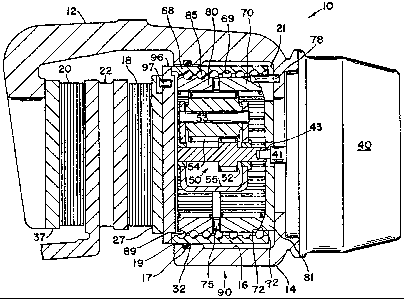Une partie des informations de ce site Web a été fournie par des sources externes. Le gouvernement du Canada n'assume aucune responsabilité concernant la précision, l'actualité ou la fiabilité des informations fournies par les sources externes. Les utilisateurs qui désirent employer cette information devraient consulter directement la source des informations. Le contenu fourni par les sources externes n'est pas assujetti aux exigences sur les langues officielles, la protection des renseignements personnels et l'accessibilité.
L'apparition de différences dans le texte et l'image des Revendications et de l'Abrégé dépend du moment auquel le document est publié. Les textes des Revendications et de l'Abrégé sont affichés :
| (12) Brevet: | (11) CA 1300045 |
|---|---|
| (21) Numéro de la demande: | 1300045 |
| (54) Titre français: | FREIN A DISQUE ELECTRIQUE |
| (54) Titre anglais: | ELECTRICALLY ACTUATED DISC BRAKE |
| Statut: | Périmé et au-delà du délai pour l’annulation |
| (51) Classification internationale des brevets (CIB): |
|
|---|---|
| (72) Inventeurs : |
|
| (73) Titulaires : |
|
| (71) Demandeurs : | |
| (74) Agent: | MACRAE & CO. |
| (74) Co-agent: | |
| (45) Délivré: | 1992-05-05 |
| (22) Date de dépôt: | 1988-04-26 |
| Licence disponible: | S.O. |
| Cédé au domaine public: | S.O. |
| (25) Langue des documents déposés: | Anglais |
| Traité de coopération en matière de brevets (PCT): | Non |
|---|
| (30) Données de priorité de la demande: | ||||||
|---|---|---|---|---|---|---|
|
ELECTRICALLY ACTUATED DISC BRAKE
ABSTRACT OF THE DISCLOSURE
The electrically actuated disc brake (10)
comprises a caliper (12) having a bore (16) receiving
therein an actuating mechanism (90), and an electric
motor (40)attached to the caliper housing (12). The
actuating mechanism (90) comprises a planetary gear
mechanism (50) which includes a sun gear (52), planetary
gears (54), and a pair of ring gears (70, 80). An actua-
tor sleeve (68) is disposed about the ring gears (70, 80)
and contains a helical groove (69) disposed opposite a
complementary-shaped helical groove (89) in a rotatable
ring gear (80). The helical grooves (69, 89) receive
therebetween a bearing mechanism (85) biased by a spring
(87) toward a fixed stop (86) located within the helical
grooves (69, 89). Operation of the electric motor (40)
effects rotation of the rotatable ring gear (80) and
axial displacement of the actuator sleeve (68) into en-
gagement with a thrust pad (96) located adjacent one of
the friction elements (18) so that the caliper (12), by
reaction, displaces the other friction element (20) into
engagement with the rotor (22).
Note : Les revendications sont présentées dans la langue officielle dans laquelle elles ont été soumises.
Note : Les descriptions sont présentées dans la langue officielle dans laquelle elles ont été soumises.

2024-08-01 : Dans le cadre de la transition vers les Brevets de nouvelle génération (BNG), la base de données sur les brevets canadiens (BDBC) contient désormais un Historique d'événement plus détaillé, qui reproduit le Journal des événements de notre nouvelle solution interne.
Veuillez noter que les événements débutant par « Inactive : » se réfèrent à des événements qui ne sont plus utilisés dans notre nouvelle solution interne.
Pour une meilleure compréhension de l'état de la demande ou brevet qui figure sur cette page, la rubrique Mise en garde , et les descriptions de Brevet , Historique d'événement , Taxes périodiques et Historique des paiements devraient être consultées.
| Description | Date |
|---|---|
| Inactive : CIB désactivée | 2012-01-07 |
| Inactive : CIB expirée | 2012-01-01 |
| Inactive : CIB du SCB | 2012-01-01 |
| Inactive : CIB de MCD | 2006-03-11 |
| Inactive : CIB de MCD | 2006-03-11 |
| Inactive : Demande ad hoc documentée | 1997-05-05 |
| Le délai pour l'annulation est expiré | 1997-05-05 |
| Lettre envoyée | 1996-05-06 |
| Accordé par délivrance | 1992-05-05 |
Il n'y a pas d'historique d'abandonnement
Les titulaires actuels et antérieures au dossier sont affichés en ordre alphabétique.
| Titulaires actuels au dossier |
|---|
| ALLIED-SIGNAL INC. |
| Titulaires antérieures au dossier |
|---|
| ALISTAIR GORDON TAIG |